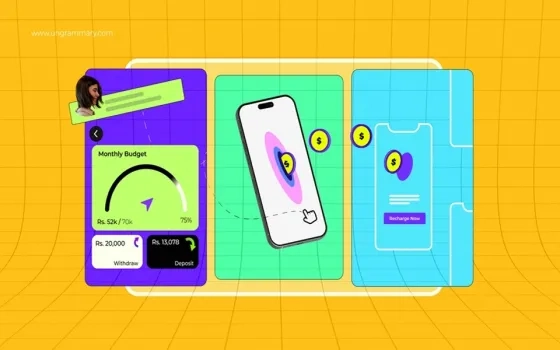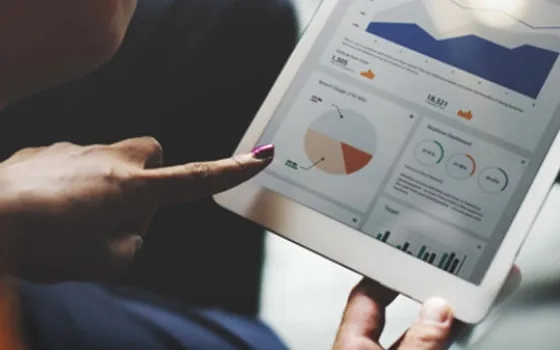In recent years, the shift towards mobile-first design has become increasingly crucial in the Financial Technology (Fintech) and Software as a Service (SaaS) domain. With mobile usage skyrocketing, users crave experiences that effortlessly bridge devices and delight at every touchpoint.
Embracing this shift isn't just beneficial—it's imperative. Crafting interfaces that excel on mobile demands a strategic overhaul from inception.
Let us engage through our blog, discussing the pivotal principles and innovative strategies driving mobile-first design in Fintech and SaaS.
The Core Principles of Mobile-First Design
Prioritizing User Needs and Context
Understanding how users interact with Fintech and SaaS applications on mobile devices is crucial for effective mobile-first design. In India, where mobile usage is pervasive, apps must cater to diverse user needs, such as quick financial transactions and seamless task management on the go.
Paytm, India's leading digital payment platform, exemplifies prioritizing user needs in mobile-first design. The app's interface is designed to facilitate effortless transactions, bill payments, and financial management, catering to users who rely on mobile devices for daily financial activities. By prioritizing features like quick recharge options and secure payment processing, Paytm ensures accessibility and ease of use, reflecting a deep understanding of user context and needs.
Optimizing for Performance and Speed
In India's varied network conditions, optimizing performance and speed is critical for mobile applications. Designers focus on minimizing loading times, conserving data usage, and ensuring smooth functionality across different network speeds to enhance user experience and reliability.
Zomato, a popular food delivery and restaurant discovery platform in India, optimizes its mobile app for performance and speed. The app loads quickly, even on 2G networks prevalent in some areas, ensuring users can browse restaurant listings, place orders, and track deliveries without delays. By optimizing data usage and implementing efficient caching strategies, Zomato enhances usability and accessibility across diverse network conditions.
Adapting to Touch Interactions
Designing for touchscreens involves creating intuitive interactions tailored to mobile devices' tactile nature. Indian apps integrate touch-friendly design principles to enhance user engagement and usability.
Ola, India's leading ride-hailing service, adapts to touch interactions through its mobile app. Users can easily book rides, track drivers, and make payments using intuitive touch gestures like tapping and swiping. The app's interface features large, clearly labeled buttons and smooth gesture-based navigation, ensuring a seamless user experience optimized for mobile use.
Ensuring Consistency Across Devices
Maintaining consistency in user experience across various devices is essential for mobile-first design success. Indian companies leverage responsive design principles to ensure seamless transitions between mobile and desktop environments.
Freshworks, a Chennai-based SaaS company, ensures consistency across its suite of customer engagement software. Products like Freshdesk and Freshsales offer cohesive experiences across mobile and desktop platforms, enabling customer support teams to manage tickets, communicate with customers, and track sales leads seamlessly.
By maintaining feature parity and visual coherence, Freshworks enhances user productivity and satisfaction across devices.
Understanding Mobile-First Design Methodologies
1. User-Centered Design (UCD)
User-Centered Design (UCD) is integral to crafting successful mobile-first experiences by prioritizing user needs, behaviors, and preferences. In the context of Indian Fintech and SaaS applications, UCD methodologies include:
-
User Research: Conducting thorough qualitative and quantitative research to gather deep insights into user motivations and pain points. For example, apps like Paytm engage in user surveys and interviews to understand how people manage their finances digitally. Insights gleaned from such research inform design decisions, ensuring the app meets user expectations for ease of financial transactions on mobile devices.
-
Personas and User Stories: Developing personas that represent diverse user segments helps in empathizing with users and aligning design decisions with their needs. For instance, SaaS platforms like Freshworks develop personas for customer support agents and sales representatives. These personas guide the design of mobile interfaces in Freshdesk and Freshsales, ensuring that features like ticket management or lead tracking are intuitive and efficient across mobile devices.
2. Responsive Design
Responsive design is pivotal in adapting interfaces seamlessly across various screen sizes and orientations, crucial for maintaining consistency and usability. Indian companies in Fintech and SaaS sectors leverage responsive design methodologies to cater to users who transition between desktops, tablets, and smartphones:
ClearTax, a popular tax filing platform in India, employs responsive design principles to ensure its application is accessible and user-friendly across devices. Whether users access the platform via desktop or mobile, they experience consistent functionalities like tax filing, investment tracking, and financial planning tools. This consistency enhances user satisfaction and efficiency, regardless of the device used.
3. Prototyping and Iterative Design
Prototyping and iterative design are essential for refining mobile-first interfaces through continuous user feedback and testing. In Indian contexts, these methodologies are exemplified by:
-
Prototyping Tools: Using tools like Figma or Adobe XD, designers prototype and iterate interface designs based on early-stage user testing. For example, Byju's, an educational technology company in India, iterates its mobile app interface based on feedback from students and educators during usability testing sessions. This iterative approach ensures that features like lesson planning, interactive quizzes, and progress tracking are optimized for educational use on mobile devices.
-
Iterative Testing: Platforms like Urban Company, a service marketplace in India, continuously refine their mobile interface through iterative testing of booking flows and service provider interactions. By gathering user feedback and data analytics, it enhances the usability and efficiency of its mobile app, improving customer satisfaction and operational effectiveness.
Proven Results and Impact
Implementing mobile-first design methodologies in Fintech and SaaS has yielded significant results, demonstrating tangible benefits across user engagement, usability, accessibility, and conversion rates:
Increased User Engagement
Robinhood, a pioneering investment app, attributes its high user engagement to its intuitive mobile interface. The app’s real-time updates and seamless transaction capabilities on mobile devices encourage active participation in stock trading and investment activities.
By prioritizing mobile-first design principles, Robinhood enhances user engagement through accessible and user-friendly interfaces that cater to investors' needs for quick, informed decisions.
Enhanced Usability and Accessibility
Salesforce’s mobile CRM solution provides sales teams with accessible data and tools on the go, improving efficiency and responsiveness to client needs. The mobile app’s intuitive interface allows sales representatives to manage leads, update opportunities, and collaborate with team members seamlessly across devices.
By optimizing for mobile-first interactions, Salesforce enhances usability and accessibility, enabling sales teams to achieve higher productivity and client satisfaction in dynamic business environments.
Improved Conversion Rates
Shopify, a leading e-commerce platform, has significantly improved conversion rates through its mobile-first design approach. The platform’s responsive storefront designs and streamlined checkout processes ensure a seamless shopping experience on mobile devices.
By prioritizing user-friendly navigation, clear call-to-actions, and optimized loading times, Shopify enhances user satisfaction and encourages higher conversion rates among mobile shoppers. The platform’s commitment to mobile-first design principles underscores its effectiveness in driving sales and maximizing revenue for online merchants.
Future Directions and Innovations in Mobile-First Design
The future of mobile-first design in Fintech and SaaS is poised for transformative advancements driven by emerging technologies. As mobile technology continues to evolve, several trends and innovations are expected to shape the landscape of digital experiences:
1. AI-Driven Personalization
Artificial Intelligence (AI) holds immense potential to revolutionize mobile-first design by enabling personalized user experiences. In Fintech and SaaS applications, AI algorithms can analyze user behavior, preferences, and historical data to deliver tailored content and recommendations.
For instance, AI-powered chatbots in banking apps can provide personalized financial advice, while CRM systems can offer predictive analytics to optimize customer interactions on mobile devices. By leveraging AI-driven personalization, companies can enhance user engagement, improve retention rates, and foster stronger customer relationships in real-time.
2. Voice Interfaces
Voice interfaces represent a paradigm shift in how users interact with mobile devices and applications. With the growing popularity of virtual assistants like Siri, Alexa, and Google Assistant, voice commands offer hands-free convenience and accessibility. In Fintech and SaaS sectors, voice-enabled applications can simplify tasks such as conducting transactions, retrieving account information, or managing schedules.
For example, voice-controlled CRM systems can update customer records and schedule follow-ups seamlessly, enhancing productivity for sales teams on the go. Integrating voice interfaces into mobile-first design not only improves usability but also expands accessibility for users with disabilities and those preferring a hands-free interaction experience.
3. Augmented Reality (AR) Integrations
Augmented Reality (AR) technology enhances the user experience by overlaying digital information onto the real world through mobile device cameras. In Fintech and SaaS applications, AR can be leveraged to provide immersive experiences such as visualizing financial data in 3D graphs or conducting virtual property tours for real estate transactions.
AR-powered applications can simulate investment scenarios or visualize project timelines directly on mobile screens, offering users a more intuitive and engaging interaction with complex information. By integrating AR into mobile-first designs, companies can differentiate their offerings, enhance user engagement, and drive innovation in digital service delivery.
4. Enhanced Security and Privacy Measures
As mobile devices become indispensable for managing sensitive financial and business information, enhancing security and privacy measures is paramount. Future mobile-first designs in Fintech and SaaS will prioritize robust encryption, biometric authentication, and secure data storage solutions to safeguard user information.
Advanced technologies like blockchain can also play a role in ensuring transparent and secure transactions in mobile banking and enterprise applications. By implementing stringent security protocols, companies can build trust with users and mitigate risks associated with cyber threats in an increasingly digital environment.
5. Integration of IoT and Wearable Devices
The Internet of Things (IoT) and wearable devices present opportunities to extend mobile-first design beyond smartphones and tablets. In Fintech, IoT devices such as smartwatches can provide real-time notifications for banking alerts or stock market updates, enhancing user engagement and accessibility to financial information.
SaaS applications can leverage IoT data from connected devices to optimize operational efficiency and deliver personalized services. By integrating IoT and wearables into mobile-first strategies, companies can create seamless cross-device experiences that cater to users' evolving needs and behaviors.
Conclusion
In conclusion, designing for mobile-first in Fintech and SaaS demands a strategic focus on simplicity, responsiveness, touch-friendly interactions, and performance optimization.
By prioritizing mobile devices from the outset, designers create interfaces that enhance usability, drive engagement, and deliver value in competitive markets.
Embracing these principles is crucial for staying ahead as technology evolves, ensuring exceptional user experiences in the digital age.














